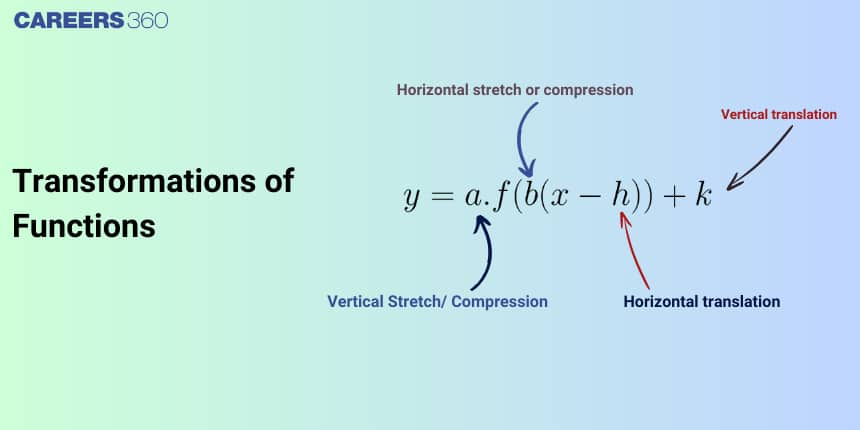Functions Transformations - Graphing, Rules, Tricks
Transformation of functions is the mathematical operations that alter the position, and size of the function. Learning how the function transforms is important in algebra. The primary types of transformations are Vertical stretches, horizontal stretches, reflections, etc. It involves moving graphs differently which helps the analyst to find different insights.
JEE Main: Study Materials | High Scoring Topics | Preparation Guide
JEE Main: Syllabus | Sample Papers | Mock Tests | PYQs

This article is about the transformation of a function which falls under the broader catergory of functions. This is an important topic not only for the board exams but also for the competitive exams.
Function:
A relation from a set
OR
Transformations of Functions
Transformation of functions moves or changes the size, position and the shape the graph of the function. The transformation of the functions can be classified into Dilation transformation, Rotation transformation, Reflection transformation and Translation transformtion.
Dilation Transformation
Dilation transformaton is when the function is transformed such that the graph of the function is either stretched or shrinked.
Stretching of a graph along the y-axis occurs if we multiply all outputs y of a function by the same positive constant (here '
Shrinking of a graph along the y-axis occurs if we multiply all outputs y of a function by the same positive constant (here '
For Example :
The graph of the function

Shrink the graph of
Stretch the graph of
For Example: The graph of
Rotation Transformation
Rotation transformaton is when the function is transformed such that the graph of the function is rotated
To rotate a graph, change the coordinates
Reflection Transformation
Reflection transformation is when the function is transformed such that the graph of the function is fliped to the opposite side without any change in the shape of size.
Transformation
When we multiply all inputs by
So, to draw
For example,
The graph of
When multiplying all the outputs by
To draw
For example
The graph of

Translation Transformation
Translation transformaton is when the function is transformed such that the graph of the function is shifted.
To translate a graph,
- Horizontally to the left,
- Horizontally to the right,
- Vertically upwards,
- Vertically downwards,
Other Transformations
When
Leave the positive part of
Now, take the image of the negative part of
OR
Take the mirror image in the x-axis of the portion of the graph of
For Example:



Transformation
When
Leave the graph lying right side of the
The part of
Now, on the left of the
For Example:



Transformation
First
Then
Or
(i)
(ii)
For Example:




Remove the part of the graph which lies below x-axis
Plot the remaining part
take the mirror image of the portion that lies above the x-axis about the x-axis.
Recommended Video Based on Transformation of Functions
Solved Examples Based on Transformation of Functions:
Example 1: The area bounded by the lines
1)
2)
3)
4)
Solution
Given the equation of curve are
and,
Plot the curve on the graph

Example 2: The number of elements in the set
1)
2)
3)
4)
Solution

No. of solutions =
Example 3: Which of the following is the graph of
1)

2)

3)

4)

Solution
As we have learnt in
1. Remove the part of the graph which lies below
2. Plot the remaining part
3. take the mirror image of the portion that lies above
First draw
Then,
Remove the part of the graph which lies below
Plot the remaining part
take the mirror image of the portion that lies above x-axis about the x-axis

Example 4: The number of solutions of
1)
2)
3)
4)
Solution
So
Hence correct option is 3
Also Read
15 Feb'25 02:33 AM
14 Feb'25 10:32 PM
11 Feb'25 11:46 PM
11 Feb'25 11:44 PM
11 Feb'25 11:41 PM
11 Feb'25 11:41 PM
11 Feb'25 06:18 PM
11 Feb'25 05:07 PM
11 Feb'25 05:00 PM
11 Feb'25 03:32 PM




